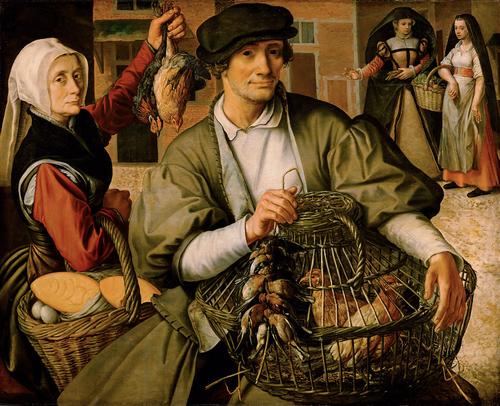CODART ZESTIEN: Market of ideas
The market of ideas has become a successful component of the CODART congress over the last four years. The market of ideas consists of interactive sessions of 30 minutes between a CODART member and a small group of colleagues. It is an opportunity to discuss with your fellow colleagues a problem or challenge in relation to your collection or museum, invite each other to collaborate on a project, consult about attributions problems, or simply get opinions, views or suggestions about issues that matter to you.
Each market table starts with a short introduction in which the market table leader explains his or her case, which then is discussed and worked out within your group.
Each congress participant has the opportunity to sign up for two market table sessions. On this page you find all the market tables for the CODART ZESTIEN congress. For a more elaborate description of each market table, see the Congress folder on the documents and downloads page.
1. Technical Studies on a Group of Paintings by Gerrit Dou
Dominique Surh and Ilona van Tuinen
The Leiden Gallery in New York houses a private collection of seventeenth-century Dutch paintings. One of the unique highlights is a group of sixteen paintings by the Leiden fijnschilder Gerrit Dou (1613-1675). The works span the full range of Dou’s career and constitute the largest group of paintings by the artist in a single collection, public or private.
2. How to keep the museum’s collection attractive with a minimum of funding and a small staff
Minerva Keltanen
A small museum like Sinebrychoff Art Museum, which is the only museum in Finland that specializes in Old Masters, faces several problems regarding its collection-related activities. For years the museum has had modest funds for new acquisitions, but lately there has been talk of putting an end to new purchases, owing to the lack of storage space.
3. Old Collections and a Fresh Garden Smell. The Case of the Rockox House and the Cathedral in Antwerp
Dr. Ria Fabri and Hildegard Van de Velde
Gardens played an important part in the intellectual life of seventeenth-century art collectors, who included not only aristocrats and members of the bourgeoisie but clerics as well. Since gardens were pre-eminently havens of rest, relaxation, recreation, sensory pleasure and spiritual perception, they invited reflection and dialogue.
4. Print vs. Screen: The future of the exhibition catalogue
Dr. Peter Carpreau and Marjan Debaene
Sales of printed exhibition catalogues are dropping. Only 2-3% of visitors to an exhibition actually purchase the catalogue. Yet the catalogue remains the primary vehicle for communicating the research and thinking that goes into producing an exhibition. It is also a lasting keepsake of a temporary event.
5. Permanent temporary exhibition: the prints case
Joanna A. Tomicka
Because of their fragility, prints – unlike paintings – cannot be put on permanent display. Paintings that belong to permanent exhibitions can serve to illustrate art history, allowing temporary exhibitions to focus on specific issues. Temporary print exhibitions must usually meet the same public needs as the paintings on permanent display.
6. Building Bridges: museums and academics. Proposals on how the museum and research center can contribute to academic training
Vanessa Paumen and Bert Watteeuw
While museums and universities often collaborate on art-historical research, collaboration seems to be more challenging when it comes to the academic training of young scholars. In this market table two institutions, the Groeningemuseum and the Rubenianum, propose two possibilities.
7. Repertory of Netherlandish Carved Altarpieces Project (RNA project)
Dr. Emile van Binnebeke
The RNA project has several aims. To begin with, it seeks to combine all current and future research on Netherlandish carved altarpieces and fragments. As scholarship develops from mere connoisseurship to professional, fundamental, scientific research programs (incorporating art-historical, archival and technical research), some researchers still rely too heavily on older catalogues based on connoisseurship.
8. The Crowning of the Victor: a Rubens or not?
Gerlinde Gruber
The Crowning of the Victor is a small panel that has recently undergone technical examination at the Kunsthistorisches Museum. Thanks to an X-radiograph from the 1930s, the composition was known to be connected with another panel by Rubens, which is now in the Museum in Kassel.
9. The two sides of Frans Floris. The stylistic confrontation of The Portrait of a Boy and The Portrait of a Guild Officer
Björn Blauensteiner
The Portrait of a Boy and The Portrait of a Guild Officer, both in the collection of the KHM and both accepted works by Frans Floris de Vriendt, differ in many respects.
10. Sculpture and the decorative arts: what use are they to CODART and museums?
Léon Lock
Since the Second World War, museums and exhibition organizers in general have increasingly placed sculpture and the decorative arts on a secondary plane of importance, far below painting and the associated arts of drawing and printmaking. In the belief that “less is more,” many museums have put their collections in storage and have concentrated on two-dimensional, preferably colorful images.
11. Exhibiting the static. Exhibitions in a furnished historic house: the case of Duivenvoorde Castle
Annette de Vries
Duivenvoorde Castle is situated between the cities of The Hague and Leiden. It originally dates from the thirteenth century, and is known in particular for its authentic architecture from the seventeenth to the nineteenth centuries, as well as its historic interiors and art collection. Since 1963 the castle has been open as a museum.
12. The Interaction of Public and Private Collections: Risks and Rewards
Anja K. Ševčík and Thomas Leysen
Highlighting a permanent collection or an exhibition by presenting previously unexhibited and rare artworks from private collections can be a successful and rewarding strategy in times of limited acquisition budgets and demanding marketing requirements.

